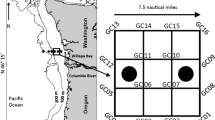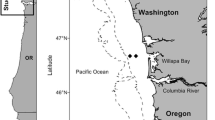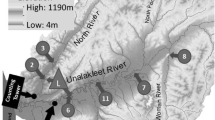Abstract
The upstream migration, spawning, and death of anadromous, semelparous Pacific salmon brings nutrients to terrestrial and aquatic communities around the Pacific Rim. Many fishes use these resources but the relationship between fish body size and the reliance on salmon-derived nutrients might follow one of several patterns related to the onset of egg consumption with body size as fish grow, and possible shifts to alternative prey such as fishes as they grow larger still. In this study, these size-dependent hypotheses of marine subsidy use by resident Dolly Varden, Salvelinus malma, were tested using diet and stable isotope analyses. S. malma did not shift abruptly to a reliance on salmon eggs after they became large enough to eat eggs (i.e., no gape limitation). Rather, fish large enough to eat eggs but < 150 mm showed diets that blended salmon nutrients with aquatic insects, likely because they were spatially segregated from the highest concentration of spawning sockeye salmon, Oncorhynchus nerka. From intermediate through the largest sizes observed (150 to > 600 mm long) S. malma received ca. 80 % of their nutrients from salmon (eggs, flesh, and maggots that had scavenged dead salmon) based on diet analysis and stable isotope ratios despite being large enough to consume fish, as many similarly-sized salmonids do in other ecosystems. The few fish sampled in June, prior to the availability of salmon subsidies, had stable isotope signatures that also reflected heavy (ca. 90 %) reliance on marine sources, likely because they had eaten little since the end of the salmon run the previous fall. This apparent avoidance of piscivory in favor a rich yet pulsed marine subsidy highlights the importance of healthy salmon runs for the sake of not only the salmon but resident fishes that consume them.





Similar content being viewed by others
References
Adkison MD (2010) Management implications of the effects of marine-derived nutrients on salmon population dynamics. Can J Fish Aquat Sci 67:1808–1815
Armstrong JB, Bond MH (2013) Phenotype flexibility in wild fish: Dolly Varden regulate assimilative capacity to capitalize on annual pulsed subsidies. J Anim Ecol 82:966–975
Armstrong JB, Schindler DE, Omori KL, Ruff CP, Quinn TP (2010) Thermal heterogeneity mediates the effects of pulsed subsidies across a landscape. Ecology 91:1445–1454
Ayllón D, Almodóvar A, Nicola GG, Elvira B (2010) Ontogenetic and spatial variations in brown trout habitat selection. Ecol Freshw Fish 19:420–432
Bilby RE, Fransen BR, Bisson PA, Walter JK (1998) Response of juvenile coho salmon (Oncorhynchus kisutch) and steelhead (Oncorhynchus mykiss) to the addition of salmon carcasses to two streams in southwestern Washington, USA. Can J Fish Aquat Sci 55:1909–1918
Chipps SR, Garvey JE (2007) Assessment of food habits and feeding patterns. In: Guy CS, Brown ML (eds) Analysis and interpretation of freshwater fisheries data. American Fisheries Society, Bethesda, pp 473–514
Craig H (1957) Isotopic standards for carbon and oxygen correction factors for mass-spectrometric analysis of carbon dioxide. Geochim Cosmochim Acta 12:133–149
Denton KP, Rich HB, Quinn TP (2009) Diet, movement, and growth of Dolly Varden in response to sockeye salmon subsidies. Trans Am Fish Soc 138:1207–1219
Denton KP, Rich HB, Moore JW, Quinn TP (2010) The utilization of a Pacific salmon Oncorhynchus nerka subsidy by three populations of charr Salvelinus spp. J Fish Biol 77:1006–1023
Eastman DE (1996) Response of freshwater fish communities to spawning sockeye salmon (Oncorhynchus nerka). Master’s thesis, University of Washington, Seattle
Ellings CS (2003) The influence of spawning Pacific salmon (Oncorhynchus spp.) on the stable isotope composition, feeding behavior, and caloric intake of coastal cutthroat trout (O. clarki clarki). Master’s thesis, Evergreen State College, Olympia
Field-Dodgson MS (1987) The effect of salmon redd exacavation on stream substrate and benthic community of two salmon spawning streams in Canterbury, New Zealand. Hydrobiologia 154:3–11
Fry B (2006) Stable isotope ecology. Springer, New York
Gende SM, Quinn TP, Willson MF (2001) Consumption choice by bears feeding on salmon. Oecologia 127:372–382
Heady WJ, Moore JS (2013) Tissue turnover and stable isotope clocks to quantify resource shifts in anadromous rainbow trout. Oecologia 172:21–34
Hilborn R, Quinn TP, Schindler DE, Rogers DE (2003) Biocomplexity and fisheries sustainability. Proc Natl Acad Sci 100:6564–6568
Jaecks TA (2010) Population dynamics and trophic ecology of Dolly Varden in the Iliamna River, Alaska: life history of freshwater fish relying on marine food subsidies. Master’s thesis, University of Washington, Seattle
Janetski DJ, Chaloner DT, Tiegs SD, Lamberti GA (2009) Pacific salmon effects on stream ecosystems: a quantitative synthesis. Oecologia 159:583–595
Johnson JH, Ringler NH (1979) Predation on Pacific salmon eggs by salmonids in a tributary of Lake Ontario. J Great Lakes Res 5:177–181
Keeley ER, Grant JWA (2001) Prey size of salmonid fishes in streams, lakes, and oceans. Can J Fish Aquat Sci 58:1122–1132
Kiljunen M, Grey J, Sinisalo T, Harrod C, Immonen H, Jones RI (2006) A revised model for lipid-normalizing δ 13C values from aquatic organisms, with implications for isotope mixing models. J Appl Ecol 43:1213–1222
Kline TC, Goering JJ, Mathisen OA, Poe PH, Parker PL (1990) Recycling of elements transported upstream by runs of pacific salmon.1. δ 15N and δ 13C evidence in Sashin Creek, Southeaster Alaska. Can J Fish Aquat Sci 47:136–144
Landry F, Post JR, Parkinson EA (1999) Spatial ontogeny of lentic age-0 rainbow trout, Oncorhynchus mykiss: whole-lake manipulations of population size structure. Can J Fish Aquat Sci 56:1916–1928
MacAvoy SE, Garman GC, Macko SA (2009) Anadromous fish as marine nutrient vectors. Fish Bull 107:165–174
Maekawa K, Nakano S (2002) Latitudinal trends in adult body size of Dolly Varden, with special reference to the food availability hypothesis. Popul Ecol 44:17–22
Mariotti A, Letolle R, Sherr E (1983) Distribution of stable nitrogen isotopes in a salt-marsh estuary. Estuaries 6:304–305
McCutchan JH, Lewis WM, Kendall C, McGrath CC (2003) Variation in trophic shift for stable isotope ratios of carbon, nitrogen, and sulfur. Oikos 102:378–390
Meehan EP, Seminet-Reneau EE, Quinn TP (2005) Bear predation on Pacific salmon facilitates colonization of carcasses by fly maggots. Am Midl Nat 153:142–151
Moore JW, Schindler DE (2008) Biotic disturbance and benthic community dynamics in salmon-bearing streams. J Anim Ecol 77:275–284
Moore JW, Semmens BX (2008) Incorporating uncertainty and prior information into stable isotope mixing models. Ecol Lett 11:470–480
Moore JW, Schindler DE, Ruff CP (2008) Habitat saturation drives thresholds in stream subsidies. Ecology 89:306–312
Nislow KH, Kynard BE (2009) The role of anadromous sea lamprey in nutrient and material transport between marine and freshwater environments. Am Fish Soc Symp 69:485–494
Nowak GM, Tabor RA, Warner EJ, Fresh KL, Quinn TP (2004) Ontogenetic shifts in habitat and diet of cutthroat trout in Lake Washington, Washington. N Am J Fish Manag 24:624–635
NRC (1996) Upstream: Salmon and Society in the Pacific Northwest. National Academy Press, Washington
Pearsons TN, Fritts AL (1999) Maximum size of chinook salmon consumed by juvenile coho salmon. N Am J Fish Manag 19:165–170
Quinn TP (2005) The behavior and ecology of Pacific salmon and trout. University of Washington Press, Seattle
Quinn TP, Dittman AH, Barrett H, Cunningham C, Bond MH (2012) Chemosensory responses juvenile coho salmon, Oncorhynchus kisutch, Dolly Varden, Salvelinus malma, and sculpins (Cottus spp.) to eggs and other tissues from adult Pacific salmon. Environ Biol Fish 95:301–307
Rinella DJ, Wipfli MS, Stricker CA, Heintz RA, Rinella MJ (2012) Pacific salmon (Oncorhynchus spp.) runs and consumer fitness: growth and energy storage in stream-dwelling salmonids increase with salmon spawner density. Can J Fish Aquat Sci 69:73–84
Rosenfeld JS, Boss S (2001) Fitness consequences of habitat use for juvenile cutthroat trout: energetic costs and benefits in pools and riffles. Can J Fish Aquat Sci 58:585–593
Ruggerone GT, Rogers DE (1992) Predation on sockeye salmon fry by juvenile coho salmon in the Chignik Lakes, Alaska: implications for salmon management. N Am J Fish Manag 12:89–102
Scheuerell MD, Moore JW, Schindler DE, Harvey CJ (2007) Varying effects of anadromous sockeye salmon on the trophic ecology of two species of resident salmonids in southwest Alaska. Freshwat Biol 52:1944–1956
Schindler DE, Scheuerell MD, Moore JW, Gende SM, Francis TB, Palen WJ (2003) Pacific salmon and the ecology of coastal ecosystems. Front Ecol Environ 1:31–37
Wipfli MS, Baxter CV (2010) Linking ecosystems, food webs, and fish production: subsidies in salmonid watersheds. Fisheries 35:373–387
Wipfli MS, Hudson J, Caouette J (1998) Influence of salmon carcasses on stream productivity: response of biofilm and benthic macroinvertebrates in southeastern Alaska, U.S.A. Can J Fish Aquat Sci 55:1503–1511
Wipfli MS, Hudson JP, Caouette JP, Chaloner DT (2003) Marine subsidies in freshwater ecosystems: Salmon carcasses increase the growth rates of stream-resident salmonids. Trans Am Fish Soc 132:371–381
Acknowledgments
This research was supported by the Alaska Department of Fish and Game Division of Sport Fish, and the H. Mason Keeler Endowment at the University of Washington, and permitted by the AGF&G and University of Washington IACUC. Field assistance was provided primarily by Cody Larson, Ian Fo and Craig Schwanke but a host of enthusiastic University of Washington and ADF&G personnel contributed as well. Editorial comments and suggestions during development of the project were thankfully received from Morgan Bond, David Beauchamp, Keith Denton and Daniel Schindler.
Author information
Authors and Affiliations
Corresponding author
Rights and permissions
About this article
Cite this article
Jaecks, T., Quinn, T.P. Ontogenetic shift to dependence on salmon-derived nutrients in Dolly Varden char from the Iliamna River, Alaska. Environ Biol Fish 97, 1323–1333 (2014). https://doi.org/10.1007/s10641-014-0221-3
Received:
Accepted:
Published:
Issue Date:
DOI: https://doi.org/10.1007/s10641-014-0221-3




